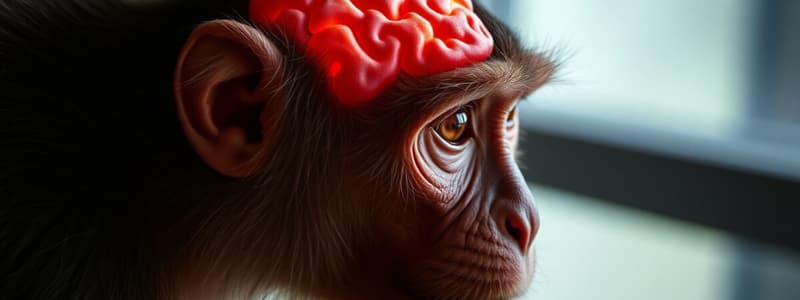Podcast
Questions and Answers
What role does grooming play in non-human primates (NHP)?
What role does grooming play in non-human primates (NHP)?
- Generates fear
- Decreases rankings
- Improves bonding (correct)
- Promotes loneliness
Humans outperform non-human primates primarily in physical tasks.
Humans outperform non-human primates primarily in physical tasks.
False (B)
What is the function of the Ventromedial Prefrontal Cortex (vmPFC)?
What is the function of the Ventromedial Prefrontal Cortex (vmPFC)?
It allows us to think about the future mental state of ourselves and others.
Damage to the ________ results in inappropriate social behavior.
Damage to the ________ results in inappropriate social behavior.
What is associated with the perception of self in the brain?
What is associated with the perception of self in the brain?
Match the following brain regions with their functions:
Match the following brain regions with their functions:
Which of the following is a result of abuse and isolation?
Which of the following is a result of abuse and isolation?
The anterior cingulate cortex (ACC) is activated when a rival team loses.
The anterior cingulate cortex (ACC) is activated when a rival team loses.
What are 'Autoscopic Hallucinations'?
What are 'Autoscopic Hallucinations'?
Which area of the brain is associated with the sense of self?
Which area of the brain is associated with the sense of self?
The __________ system provides rapid development of olfactory learning.
The __________ system provides rapid development of olfactory learning.
The Self-Reference Effect is related to better encoding of information.
The Self-Reference Effect is related to better encoding of information.
Match the following brain regions with their functions:
Match the following brain regions with their functions:
Which circuit is associated with feelings of unpleasantness?
Which circuit is associated with feelings of unpleasantness?
The left MPFC is active when thinking about oneself.
The left MPFC is active when thinking about oneself.
Damage to the __________ area can lead to issues with language production.
Damage to the __________ area can lead to issues with language production.
Flashcards
Mentalizing
Mentalizing
Inferring the mental state of others.
Introspection
Introspection
Knowledge about oneself.
Grooming in NHPs
Grooming in NHPs
Improves bonding, rank reminders, releases opioids, and offers predator protection.
Eusociality
Eusociality
Signup and view all the flashcards
Social Cognition Networks
Social Cognition Networks
Signup and view all the flashcards
Anterior Cingulate Cortex (ACC)
Anterior Cingulate Cortex (ACC)
Signup and view all the flashcards
Ventromedial Prefrontal Cortex (vmPFC)
Ventromedial Prefrontal Cortex (vmPFC)
Signup and view all the flashcards
Posterior Cingulate Cortex
Posterior Cingulate Cortex
Signup and view all the flashcards
Medial Parietal Cortex
Medial Parietal Cortex
Signup and view all the flashcards
Orbitofrontal Cortex (OFC) damage
Orbitofrontal Cortex (OFC) damage
Signup and view all the flashcards
Self-Reference Effect
Self-Reference Effect
Signup and view all the flashcards
Medial-Prefrontal Cortex
Medial-Prefrontal Cortex
Signup and view all the flashcards
Sense of Self
Sense of Self
Signup and view all the flashcards
Default Mode Network (DMN)
Default Mode Network (DMN)
Signup and view all the flashcards
Positive Self-Appraisal
Positive Self-Appraisal
Signup and view all the flashcards
Ventral Anterior Cingulate Cortex
Ventral Anterior Cingulate Cortex
Signup and view all the flashcards
OFC Role in Accuracy
OFC Role in Accuracy
Signup and view all the flashcards
VDIRT
VDIRT
Signup and view all the flashcards
Angular Gyrus and TPJ
Angular Gyrus and TPJ
Signup and view all the flashcards
Out-of-body experience
Out-of-body experience
Signup and view all the flashcards
Autoscopic hallucinations
Autoscopic hallucinations
Signup and view all the flashcards
TPJ (Temporoparietal Junction)
TPJ (Temporoparietal Junction)
Signup and view all the flashcards
Mirror Neuron Network
Mirror Neuron Network
Signup and view all the flashcards
MPFC (Medial Prefrontal Cortex)
MPFC (Medial Prefrontal Cortex)
Signup and view all the flashcards
Ventral MPFC
Ventral MPFC
Signup and view all the flashcards
Dorsal MPFC
Dorsal MPFC
Signup and view all the flashcards
Anterior Cingulate Cortex (ACC)
Anterior Cingulate Cortex (ACC)
Signup and view all the flashcards
Insula
Insula
Signup and view all the flashcards
Amygdala
Amygdala
Signup and view all the flashcards
Dorsal Anterior Cingulate Cortex
Dorsal Anterior Cingulate Cortex
Signup and view all the flashcards
Right MPFC
Right MPFC
Signup and view all the flashcards
Left MPFC
Left MPFC
Signup and view all the flashcards
Dorsal Medial Prefrontal Cortex
Dorsal Medial Prefrontal Cortex
Signup and view all the flashcards
Nucleus Accumbens
Nucleus Accumbens
Signup and view all the flashcards
Ventral Striatum
Ventral Striatum
Signup and view all the flashcards
vmPFC (Ventromedial Prefrontal Cortex)
vmPFC (Ventromedial Prefrontal Cortex)
Signup and view all the flashcards
Social support
Social support
Signup and view all the flashcards
Autism Spectrum Disorder (ASD)
Autism Spectrum Disorder (ASD)
Signup and view all the flashcards
Broca's area
Broca's area
Signup and view all the flashcards
Prefrontal cortex
Prefrontal cortex
Signup and view all the flashcards
DLPFC (Dorsolateral Prefrontal Cortex)
DLPFC (Dorsolateral Prefrontal Cortex)
Signup and view all the flashcards
Study Notes
Mentalizing and Introspection
- Mentalizing involves inferring the mental state of others.
- Introspection refers to self-knowledge.
Non-Human Primate (NHP) Social Behavior
- Grooming in NHPs improves bonding and social status, and releases opioids.
- It also provides protection from predators due to stronger social relationships.
- Humans excel in social domains over NHPs, although physical prowess is a less clear distinction.
Social Cognition Networks
- Anterior Cingulate Cortex (ACC): Involved in motivation, decision-making, conflict resolution, and error monitoring.
- Ventromedial Prefrontal Cortex (vmPFC): Important for self-referential processing and monitoring subjective feelings.
- Posterior Cingulate Cortex: Plays a role in planning and prediction.
- Medial Parietal Cortex: Functions in social-emotional processing and perception.
Orbitofrontal Cortex (OFC) Damage
- Damage to the OFC leads to inappropriate social behavior.
Abuse and Isolation Effects
- Abuse and isolation lead to impaired synaptic plasticity.
- Increased fear, aggression, and anxiety result from such circumstances.
- Prefrontal cortex function is negatively impacted.
- Reduced dopamine levels and increased serotonin levels are observed.
- Perception of isolation predicts Alzheimer's disease risks, lower IQ over time, and depression.
- Correlated with decreased glucocorticoid receptor sensitivity.
- Increased Default Mode Network (DMN) sensitivity.
Self-Reference Effect
- Information processed in relation to the self is better encoded and recalled.
- The medial-prefrontal cortex (MPFC) shows heightened activity during this process.
Sense of Self
- The posterior parietal cortex is involved in the sense of self.
- The DMN plays a role in the sense of self, with the MPFC showing heightened activity even at rest.
- Key DMN components include the ventral medial prefrontal cortex, dorsal medial prefrontal cortex, inferior parietal lobule, retrosplenial cingulate cortex, and temporal parietal junction.
- The VDIRT (self-reflection, future actions, current condition, other beliefs and actions) network.
Positive Self-Appraisal
- The anterior cingulate cortex (ACC) is part of positive self-appraisal.
- The ventral anterior cingulate cortex focuses attention on self-appraisal.
- The OFC allows for accurate self-perception.
Ventromedial Prefrontal Cortex (vmPFC)
- The vmPFC helps to predict future mental states of ourselves and others.
- It allows for simulation of social scenarios.
- The vmPFC's activity increases when choosing to delay gratification.
- Damage to this area impairs the ability to predict likes and dislikes.
Angular Gyrus and Temporoparietal Junction (TPJ)
- The angular gyrus and TPJ mediate the link between self and body.
- Stimulating the angular gyrus may disrupt the self-body connection.
- Out-of-body experiences and similar phenomena may be related.
- The TPJ enables perspective-taking and the understanding of other people's viewpoints, as well as out-of-body experiences.
Autoscopic Hallucinations
- Autoscopic hallucinations involve seeing a double of oneself but without feeling out of body.
- May result from a failure to integrate vestibular and visual input or proprioceptive and tactile input.
Early Development
- Babies' occipital cortex shows gamma-range activation when processing facial expressions.
- Activated prefrontal cortex in response to eye contact.
- Dampened amygdala to help associate the mother with positive experiences.
- Noradrenergic system for rapid olfactory learning development.
Ventral vs. Dorsal MPFC
- Ventral MPFC is activated when perceiving self or similar others, such as romantic partners.
- Dorsal MPFC is activated when perceiving dissimilar others.
Mirror Neuron Network
- The mirror neuron network (consisting of MPFC, VLPFC, Anterior Cingulate Gyrus) connects with the amygdala via the insula.
Unpleasantness Circuit
- The anterior cingulate cortex and anterior insula are part of the unpleasantness circuit.
Processing Self vs. Others
- Dorsal ACC is active during self-processing but not during other-processing.
- Right MPFC is active during self-thought, while the left MPFC is active when thinking about others.
- Dorsal medial prefrontal cortex is involved when considering other's behaviors.
Fairness and Cheating
- Activation of the insula and ACC for fair players.
- Nucleus accumbens and ventral striatum activation in males during cheating.
- ACC activation when a favorite team loses.
- Ventral striatum activation when a rival team loses—Schadenfreude.
Frontotemporal Dementia (FTDL)
- FTDL patients may view negative behaviors as more acceptable.
- The vmPFC is required for a balanced perception.
Intentional vs. Accidental Harm
- The amygdala associates intentional and accidental harm.
- TPJ stimulation can decrease the amygdala's response to unintentional transgressions—"no harm, no foul."
Decision-Making Processes
- DLPFC and PFC are involved in rule-based decisions.
- TPJ and Parietal areas are associated with personal experience.
Social Support
- Social support inhibits amygdala activity.
- It suppresses pain and threat detection.
- Opioid release, decreased HPA and SNS activation.
- An increase in vmPFC activity is involved.
- Inhibition of insula and ACC.
Autism Spectrum Disorder (ASD)
- Default Mode Network (DMN) is consistently underactive in ASD.
- Immature spines are present in neurons of the hippocampus.
Brain Damage and Cognitive Deficits
- Damage to Broca's area, supplementary motor area, basal ganglia, thalamus, ACC, OFC, and posterior parietal cortex are associated with cognitive impairments.
Studying That Suits You
Use AI to generate personalized quizzes and flashcards to suit your learning preferences.




